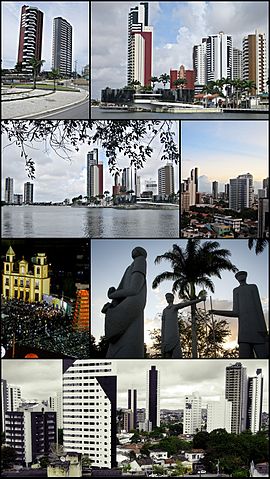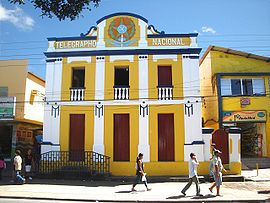Campina Grande
| Campina Grande | ||
|---|---|---|
|
Coordinates: 7 ° 14 ′ S , 35 ° 53 ′ W Campina Grande on the map of Brazil
|
||
| Basic data | ||
| Country | Brazil | |
| State | Paraíba | |
| City foundation | 1864 | |
| Residents | 400.002 (2013) | |
| City insignia | ||
| Detailed data | ||
| surface | 621 km 2 | |
| Population density | 598 inhabitants / km 2 | |
| height | 552 m | |
| Time zone | UTC −3 | |
| City Presidency | Romero Rodrigues | |
| Website | ||
| View of Campina Grande | ||
| Historical Museum in Campina Grande | ||
Campina Grande , officially Município de Campina Grande , is the second largest city in the Brazilian state of Paraíba . It is located 120 km from João Pessoa , the capital of the state, in the hinterland.
history
The settlement of today's Campina Grande began around 1697. The place was until then the area of the Ariús -Indios. Around 1698 a monk of the convent of St. Anthony from Joâo Pessoa came to Campina Grande at the invitation of the governor to negotiate with the Indians about their rights and to enforce their proselytizing.
On January 13, 1701, the first chapel was built. In the years that followed, a lot of mandioca , maize and other cereals were grown. Campina Grande became an important hub for the transport of goods between the coast and the hinterland of Paraiba state. Around 1790 the place was named Vila Nova da Rainha . Around 1814 there was the first municipal administration office. The Açude Velho , the now "old" water reservoir, was filled in around 1820 and in 1822 the first school in Campina Grande was founded. In 1829 there was the first regular postal connection to the town. In 1864 Campina Grande received city rights. At that time there were around 4,000 residents there.
In 1896 the first telegraph company was founded in Campina Grande. The first railway station opened on October 2, 1907. From 1909 there was the first cinema in the city. In 1914 the first automobile was spotted, a Studebaker . The first football club for amateurs, Campinense Clube , was founded in 1914. In 1922 the “Monument to Independence” was built in front of the Paço Municipal . In 1925 the first market, Mercado Municipal, opened. The Treze football club was also founded in 1925. The Banco Industrial de Campina Grande has existed since 1927 . In 1940 the Aero Club Campina Grande was founded.
Cotton production was the main economic activity in Campina Grande until the early 20th century and was responsible for the city's growth. It attracted traders from all regions of Paraíbas and all of the Northeast. By the 1940s, Campina Grande was the second largest exporter of cotton in the world after Liverpool, England . For this reason, Campina Grande was also called "Brazilian Liverpool". The processing of cotton led to a significant increase in the construction of railway lines into the city. Transport by train represented a big change in the local economy: Campina could more easily export cotton and import other products from the nearest ports, especially in Recife. Because of the coffee crisis in São Paulo at the beginning of the 20th century, cotton production developed into an economic alternative in competition with the production of Campina Grande. Due to cotton production, the population of Campina Grande grew from 20,000 in 1907 to 130,000 in 1939, an increase of 650% in 32 years. By 1931, the Greater São Paulo area had become the largest producer of cotton in Brazil, producing 23 million pounds of cotton. In 1933 São Paulo was already producing 105 million pounds of cotton compared to 3.9 million in 1929. This contributed to the decline in cotton production in Campina Grande, the main reasons being:
- Lack of a port in Paraiba for large cargo, so Campina Grande had to use the port of Recife
- Pest infestation of the monocultures, which destroyed large parts of the harvest over several years
- The high price compared to the product from São Paulo
- Large number of other foreign companies in the cotton market
During the 20th century, the capital of Paraíba, João Pessoa, lost its importance and the rise of Campina Grande, the second largest city in the state, began. The economy in Joao Pessoa practically stagnated during the first half of the century. Since the 1960s, after major private investment and government, both state government and the federal government, Joao Pessoa gained new prominence, and reaffirmed its position as the capital of the state in economic terms.
In 1949 the Cariri radio station was opened. The first SENAI Polytechnic School in Campina Grande was founded in 1952. Since 1960 there has also been a faculty of the Federal University of Paraíba in Campina Grande, and since the beginning of the 21st century this Federal University has been called Campina Grande (UFCG). The Téatro Municipal Severino Cabral was completed in 1962. On March 14, 1966, Televisão Borborema Ltda. as the first television station in the city to start broadcasting. The Assis Chateaubriand Art Museum opened in 1967. The Campina Grande Medical School has been operating since 1968. The Governador Ernani Sátiro O Amigão stadium opened in 1974. The Center for Science and Technology has worked for the city since 1974. Since 1982 there is a cultural center and a shopping center in Campina Grande. In 1985 the Parque de Povo - a central event space - and the bus station were completed, in 1993 the children's park. The international center for Brazilian software TecOut Center has existed since 2004 . In 2006 a new local transport system was introduced.
Today the city has about 360,000 inhabitants.
Distances between Campina Grande and some state capitals:
|
|
Diocese of Campina Grande
climate
Campina Grande lies between the coast and Sertão and, due to its height of 552 meters, has a milder climate than the dry, hot hinterland and the hot and humid coastal strip. The maximum temperatures can reach 31 to 32 ° C in summer and 25 to 28 ° C in winter. The minimum temperature is 23 ° C on the hottest summer days and 15 ° C on the coldest nights of the year. The relative humidity is usually between 75 and 82%. Winter starts in May and ends in August, otherwise no real seasons are perceived. The winter is characterized above all by the rainy season, during which heavy rainfall occurs at times. Towards the end of the 20th and the beginning of the 21st century, the city experienced a number of years in which the winter rain was insufficient to replenish its water reserves. The water therefore had to be rationed. On certain days, the water supply of certain city districts was completely stopped after announcement.
sons and daughters of the town
- Antonio Dias (1944-2018), artist
- Marcelinho (* 1975), football player
- Fábio Bilica (* 1979), football player
- Hulk (* 1986), soccer player
Web links
- City Prefecture website , Prefeitura Municipal (Portuguese)
- City Council website , Câmara Municipal (Portuguese)






